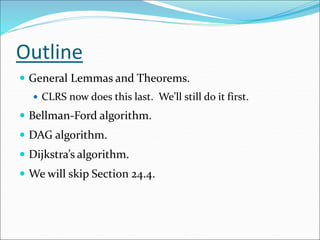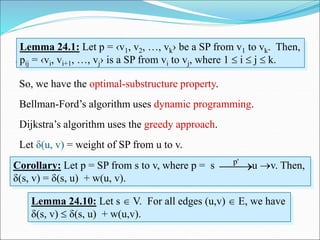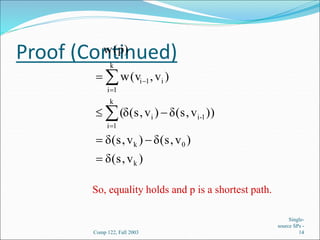This document discusses several algorithms for finding single-source shortest paths in graphs:
1) Bellman-Ford algorithm can handle graphs with negative edge weights by detecting negative cycles. It runs in O(VE) time.
2) For directed acyclic graphs (DAGs), topological sorting followed by relaxation yields the shortest paths from a single source in O(V+E) time.
3) Dijkstra's algorithm uses a greedy approach to find single-source shortest paths in graphs with non-negative edge weights.



![RelaxationInitialize(G, s)
for each v V[G] do
d[v] := ;
[v] := NIL
od;
d[s] := 0
Relax(u, v, w)
if d[v] > d[u] + w(u, v) then
d[v] := d[u] + w(u, v);
[v] := u
fi
Algorithms keep track of d[v], [v]. Initialized as follows:
These values are changed when an edge (u, v) is relaxed:](https://image.slidesharecdn.com/singlesourceshortestpath-220527062105-7440d52d/85/SINGLE-SOURCE-SHORTEST-PATH-ppt-4-320.jpg)
![Properties of Relaxation
d[v], if not , is the length of some path from s to v.
d[v] either stays the same or decreases with time
Therefore, if d[v] = (s, v) at any time, this holds
thereafter
Note that d[v] (s, v) always
After i iterations of relaxing on all (u,v), if the shortest
path to v has i edges, then d[v] = (s, v).
Comp 122, Fall 2003
Single-
source SPs -
5](https://image.slidesharecdn.com/singlesourceshortestpath-220527062105-7440d52d/85/SINGLE-SOURCE-SHORTEST-PATH-ppt-5-320.jpg)
![Properties of Relaxation
Comp 122, Fall 2003
Single-
source SPs -
6
Consider any algorithm in which d[v], and [v] are first initialized
by calling Initialize(G, s) [s is the source], and are only changed by
calling Relax. We have:
Lemma 24.11: ( v:: d[v] (s, v)) is an invariant.
Implies d[v] doesn’t change once d[v] = (s, v).
Proof:
Initialize(G, s) establishes invariant. If call to Relax(u, v, w)
changes d[v], then it establishes:
d[v] = d[u] + w(u, v)
(s, u) + w(u, v) , invariant holds before call.
(s, v) , by Lemma 24.10.
Corollary 24.12: If there is no path from s to v, then
d[v] = δ(s, v) = is an invariant.](https://image.slidesharecdn.com/singlesourceshortestpath-220527062105-7440d52d/85/SINGLE-SOURCE-SHORTEST-PATH-ppt-6-320.jpg)
![More Properties
Comp 122, Fall 2003
Single-
source SPs -
7
Lemma 24.14: Let p = SP from s to v, where p = s u v.
If d[u] = δ(s, u) holds at any time prior to calling Relax(u, v, w),
then d[v] = δ(s, v) holds at all times after the call.
p'
Proof:
After the call we have:
d[v] d[u] + w(u, v) , by Lemma 24.13.
= (s, u) + w(u, v) , d[u] = (s, u) holds.
= (s, v) , by corollary to Lemma 24.1.
By Lemma 24.11, d[v] δ(s, v), so d[v] = δ(s, v).
Lemma 24.13: Immediately after relaxing edge (u, v) by calling
Relax(u, v, w), we have d[v] d[u] + w(u, v).](https://image.slidesharecdn.com/singlesourceshortestpath-220527062105-7440d52d/85/SINGLE-SOURCE-SHORTEST-PATH-ppt-7-320.jpg)

![Predecessor Subgraph
Comp 122, Fall 2003
Single-
source SPs -
9
Lemma 24.16: Assume given graph G has no negative-weight cycles
reachable from s. Let G = predecessor subgraph. G is always a
tree with root s (i.e., this property is an invariant).
Proof:
Two proof obligations:
(1) G is acyclic.
(2) There exists a unique path from source s to each vertex in V.
Proof of (1):
Suppose there exists a cycle c = ‹v0, v1, …, vk›, where v0 = vk.
We have [vi] = vi-1 for i = 1, 2, …, k.
Assume relaxation of (vk-1, vk) created the cycle.
We show cycle has a negative weight.
Note: Cycle must be reachable from s. (Why?)](https://image.slidesharecdn.com/singlesourceshortestpath-220527062105-7440d52d/85/SINGLE-SOURCE-SHORTEST-PATH-ppt-9-320.jpg)
![Proof of (1) (Continued)
Comp 122, Fall 2003
Single-
source SPs -
10
Before call to Relax(vk-1, vk, w):
[vi] = vi-1 for i = 1, …, k–1.
Implies d[vi] was last updated by “d[vi] := d[vi-1] + w(vi-1, vi)”
for i = 1, …, k–1. [Because Relax updates .]
Implies d[vi] d[vi-1] + w(vi-1, vi) for i = 1, …, k–1. [Lemma 24.13]
Because [vk] is changed by call, d[vk] > d[vk-1] + w(vk-1, vk). Thus,
cycle!
weight
-
neg.
i.e.,
0,
)
v
,
w(v
,
]
d[v
]
d[v
Because
)
v
,
w(v
]
d[v
))
v
,
w(v
]
(d[v
]
d[v
k
1
i
i
1
i
k
1
i
1
i
k
1
i
i
k
1
i
k
1
i
i
1
i
1
i
k
1
i
k
1
i
i
1
i
1
i
i
](https://image.slidesharecdn.com/singlesourceshortestpath-220527062105-7440d52d/85/SINGLE-SOURCE-SHORTEST-PATH-ppt-10-320.jpg)
![Comment on Proof
d[vi] d[vi-1] + w(vi-1,vi) for i = 1, …, k–1 because when
Relax(vi-1 ,vi , w) was called, there was an equality, and
d[vi-1] may have gotten smaller by further calls to Relax.
d[vk] > d[vk-1] + w(vk-1,vk) before the last call to Relax
because that last call changed d[vk].
Comp 122, Fall 2003
Single-
source SPs -
11](https://image.slidesharecdn.com/singlesourceshortestpath-220527062105-7440d52d/85/SINGLE-SOURCE-SHORTEST-PATH-ppt-11-320.jpg)

![Lemma 24.17
Comp 122, Fall 2003
Single-
source SPs -
13
Lemma 24.17: Same conditions as before. Call Initialize & repeatedly
call Relax until d[v] = δ(s, v) for all v in V. Then, G is a shortest-path
tree rooted at s.
Proof:
Key Proof Obligation: For all v in V, the unique simple path p from
s to v in G (path exists by Lemma 24.16) is a shortest path from s to v
in G.
Let p = ‹v0, v1, …, vk›, where v0 = s and vk = v.
We have d[vi] = δ(s, vi)
d[vi] d[vi-1] + w(vi-1, vi) (reasoning as before)
Implies w(vi-1, vi) δ(s, vi) – δ(s, vi-1).](https://image.slidesharecdn.com/singlesourceshortestpath-220527062105-7440d52d/85/SINGLE-SOURCE-SHORTEST-PATH-ppt-13-320.jpg)

![Bellman-Ford Algorithm
Comp 122, Fall 2003
Single-
source SPs -
15
Can have negative-weight edges. Will “detect” reachable negative-weight
cycles.
Initialize(G, s);
for i := 1 to |V[G]| –1 do
for each (u, v) in E[G] do
Relax(u, v, w)
od
od;
for each (u, v) in E[G] do
if d[v] > d[u] + w(u, v) then
return false
fi
od;
return true
Time
Complexity
is O(VE).](https://image.slidesharecdn.com/singlesourceshortestpath-220527062105-7440d52d/85/SINGLE-SOURCE-SHORTEST-PATH-ppt-15-320.jpg)







![Lemma 24.2
Comp 122, Fall 2003
Single-
source SPs -
23
Lemma 24.2: Assuming no negative-weight cycles reachable from
s, d[v] = (s, v) holds upon termination for all vertices v reachable
from s.
Proof:
Consider a SP p, where p = ‹v0, v1, …, vk›, where v0 = s and vk = v.
Assume k |V| – 1, otherwise p has a cycle.
Claim: d[vi] = (s, vi) holds after the ith pass over edges.
Proof follows by induction on i.
By Lemma 24.11, once d[vi] = (s, vi) holds, it continues to hold.](https://image.slidesharecdn.com/singlesourceshortestpath-220527062105-7440d52d/85/SINGLE-SOURCE-SHORTEST-PATH-ppt-23-320.jpg)
![Correctness
Comp 122, Fall 2003
Single-
source SPs -
24
Claim: Algorithm returns the correct value.
(Part of Theorem 24.4. Other parts of the theorem follow easily from earlier results.)
Case 1: There is no reachable negative-weight cycle.
Upon termination, we have for all (u, v):
d[v] = (s, v) , by lemma 24.2 (last slide) if v is reachable;
d[v] = (s, v) = otherwise.
(s, u) + w(u, v) , by Lemma 24.10.
= d[u] + w(u, v)
So, algorithm returns true.](https://image.slidesharecdn.com/singlesourceshortestpath-220527062105-7440d52d/85/SINGLE-SOURCE-SHORTEST-PATH-ppt-24-320.jpg)
![Case 2
Comp 122, Fall 2003
Single-
source SPs -
25
Case 2: There exists a reachable negative-weight cycle
c = ‹v0, v1, …, vk›, where v0 = vk.
We have i = 1, …, k w(vi-1, vi) < 0. (*)
Suppose algorithm returns true. Then, d[vi] d[vi-1] + w(vi-1, vi) for
i = 1, …, k. (because Relax didn’t change any d[vi] ). Thus,
i = 1, …, k d[vi] i = 1, …, k d[vi-1] + i = 1, …, k w(vi-1, vi)
But, i = 1, …, k d[vi] = i = 1, …, k d[vi-1].
Can show no d[vi] is infinite. Hence, 0 i = 1, …, k w(vi-1, vi).
Contradicts (*). Thus, algorithm returns false.](https://image.slidesharecdn.com/singlesourceshortestpath-220527062105-7440d52d/85/SINGLE-SOURCE-SHORTEST-PATH-ppt-25-320.jpg)
![Shortest Paths in DAGs
Comp 122, Fall 2003
Single-
source SPs -
26
Topologically sort vertices in G;
Initialize(G, s);
for each u in V[G] (in order) do
for each v in Adj[u] do
Relax(u, v, w)
od
od](https://image.slidesharecdn.com/singlesourceshortestpath-220527062105-7440d52d/85/SINGLE-SOURCE-SHORTEST-PATH-ppt-26-320.jpg)







![Dijkstra’s Algorithm
Comp 122, Fall 2003
Single-
source SPs -
34
Assumes no negative-weight edges.
Maintains a set S of vertices whose SP from s has been determined.
Repeatedly selects u in V–S with minimum SP estimate (greedy choice).
Store V–S in priority queue Q.
Initialize(G, s);
S := ;
Q := V[G];
while Q do
u := Extract-Min(Q);
S := S {u};
for each v Adj[u] do
Relax(u, v, w)
od
od](https://image.slidesharecdn.com/singlesourceshortestpath-220527062105-7440d52d/85/SINGLE-SOURCE-SHORTEST-PATH-ppt-34-320.jpg)





